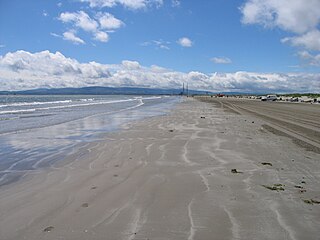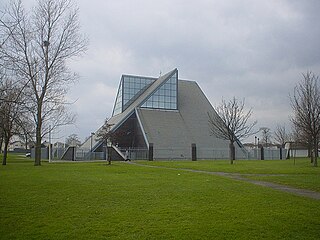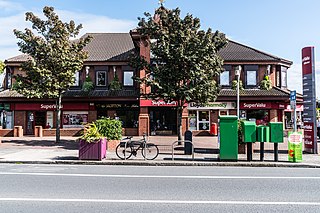
Arthur Edward Guinness, 1st Baron Ardilaun, 2nd Baronet, known as Sir Arthur Guinness, Bt, between 1868 and 1880, was an Irish businessman, politician, and philanthropist, best known for giving St Stephen's Green to the Dublin Corporation for public use.

Raheny is a northern suburb of Dublin, Ireland, halfway from the city centre to Howth. It is centred on a historic settlement, first documented in 570 AD. The district shares Dublin's two largest municipal parks, Saint Anne's Park and Bull Island with its 4.5 km beach, with neighbouring Clontarf, and is crossed by several small watercourses.

Baldoyle is a coastal suburb of Dublin's northside. It is located in the southeastern part of the jurisdiction of Fingal, Ireland, developed from a former fishing village.

Artane, sometimes spelt Artaine, historically Tartaine is a northside suburb of Dublin city, Ireland.

Bull Island, more properly North Bull Island, is an island located in Dublin Bay in Ireland, about 5 km long and 800 m wide, lying roughly parallel to the shore off Clontarf, Raheny, Kilbarrack, and facing Sutton. The island, with a sandy beach known as Dollymount Strand running its entire length, is a relatively recent, and inadvertent, result of human intervention in the bay. The island lies within the jurisdiction of, and is mostly owned by, Dublin City Council, and is managed by the Council's Parks and Landscape Division.

Clontarf is an affluent coastal suburb on the Northside of Dublin in the city's Dublin 3 postal district. Historically, there were two centres of population, one on the coast towards the city, and the fishing village of Clontarf Sheds, further north on the coast at what is now Vernon Avenue. Clontarf has a range of retail businesses in several locations, mainly centred on Vernon Avenue. It adjoins Fairview, Marino, Killester and Raheny. Clontarf is in the jurisdiction of Dublin City Council.

Saint Anne's Park is a 240-acre (97 ha) public park situated between Raheny and Clontarf, suburbs on the northside of Dublin, Ireland. It is owned and managed by Dublin City Council.

Donaghmede is a mixed socio-economic residential suburb on the northern side of Dublin, Ireland, formed from parts of Baldoyle, Coolock and Raheny in the 1970s. It contains a mid-size shopping centre and a ruined chapel, and lies within the jurisdiction of Dublin City Council.

Killester is a small residential suburb of Dublin, Ireland on the Northside of the city in the Dublin 3 and Dublin 5 postal districts. It was the site of a church and convent or monastery centuries ago, and later a small village developed. In 1922, a settlement for ex-servicemen and their families was established, and the area grew with suburban housing later. The local parish church has for many years hosted a relic of St Brigid.
Donnycarney is a Northside suburb in the city of Dublin, Ireland, in the jurisdiction of Dublin City Council. It is mostly residential, around 5 kilometres (3.1 mi) from the centre of Dublin. Dublin GAA's home stadium, Parnell Park, is located here.

The Naniken River is a minor river on the north side of Dublin city, Ireland, one of more than forty watercourses monitored by Dublin City Council. It is culverted for its upper course, visible in St Anne's Park for its entire lower course, and causes flooding somewhere along its line most years. The river flows entirely within the jurisdiction of Dublin City Council.

St. Assam's is the name of two historic churches in the village of Raheny, Dublin, one a ruin in the middle of the village, one the structurally sound but no longer primary church built for the local Roman Catholic community of the area after the revival of religious rights. Both buildings lie within the area of the ráth which gave the village and district its name, and which was perhaps 110 m across.

All Saints' Church is the Church of Ireland Parish Church of the Parish of Raheny, prominent on the Howth Road as it approaches the centre of Raheny, Dublin, Ireland. It lies in walled grounds with mature tree cover, just south of the village core, and is widely hailed as a fine architectural specimen.
Founded in the early days of Irish Christian parish structures, the Parish of Clontarf assumed in 1829 the mantle of Union Parish for a large area of north Dublin, Ireland, a role previously filled by the Parish of Coolock, into which Clontarf had been subsumed in 1614 - refer to that article for history from 1618 to 1879. Clontarf itself is a large northside suburb of Dublin, and the parish was in the 20th century divided into the modern parishes which now serve that area.
The Parish of Raheny is the modern successor in the Roman Catholic Church to an early (1152) parish, in Raheny, a district of Dublin, Ireland, reputed to be a site of Christian settlement back to at least 570 A.D. Today's parish, within the Howth Deanery of the Roman Catholic Archdiocese of Dublin, comprises Raheny village and the central portion of the district, parts of which are also served by the parishes of Killester, Grange Park and Kilbarrack-Foxfield. The parish has a membership of around 10,000 Catholics. Similarly centred, and covering a greater land area but a much smaller membership, is the Church of Ireland parish of the same name.
The Parish of Raheny is the modern successor in the Church of Ireland to an early (1152) parish, in Raheny, a district of Dublin reputed to be a site of Christian settlement back to 570. Today's parish comprises Raheny village and the wider district, and is in a Union with the Parish of Coolock. Its parish church is All Saints' Church, Raheny.
The Clontarf and Hill of Howth Tramroad Company (C&HoHTCo) operated a tram service from central Dublin via Dollymount in Clontarf to Howth Harbour in the Dublin area of Ireland from 1900 to 1941. Formed in the 1880s, it was a separate entity from the other Dublin tramways, notably the Dublin United Tramways Company (DUTC), but worked closely with the latter, who owned the line as far as Dollymount, for most of its operating existence.
Benjamin John Plunket was a 20th-century Anglican bishop in Ireland.
Simon "Sam" Clyne was an educational leader in Ireland, President of St Patrick's College, Drumcondra, the country's largest college of education, and a commentator on educational matters. A Vincentian priest and PhD holder, Sam Clyne also served as Principal of Castleknock College and as chaplain to the President of Ireland.
Holy Faith Secondary School, Clontarf is a girls' voluntary second level school in Clontarf on the Northside of Dublin, Ireland. Founded by the Holy Faith Sisters in 1890, and originally providing both primary and secondary education, it is since 2009 in the care of The Le Cheile Schools Trust. It is notable as one of the 25 schools with the highest progression to third level education. In 2020 it was ranked 1st in North Dublin, and 7th in Ireland, by the Sunday Times.












